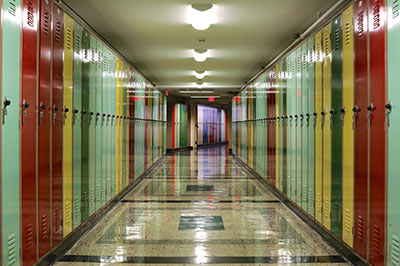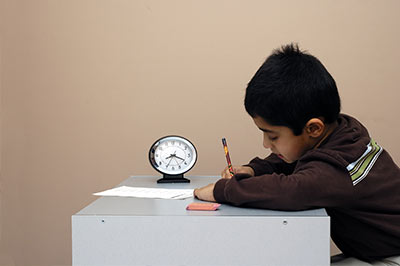Tanner, C. K. (2014). Linking measurements of the physical environment’s physiognomies to human behavior and productivity is a rather new task in the fields of education, and social and natural sciences. In education; for example, how can a schoolhouse and its surroundings be measured such that valid and reliable comparisons can be made among student outcomes? For example, how do school environments influence student behavior and other outcomes? How do we quantify specific features of the physical environment of the school? Obviously, we already accept the quantification of student testing and other measurable outcomes based on our continual dependence on standardized tests for making decisions. The article approaches this issue through rules of consistent measurement and mapping practices. Three common measurement scales, nominal, ordinal, and interval scales are compared. The nominal scale is shown to be of unequivocally no value in making quantitative comparisons, beyond classifying and categorizing assigned values. The ordinal and interval scales may be considered as vectors having magnitude and direction, while the nominal scale does not fit into correlations, regression, and prediction equations because the nominal classification cannot show direction or specify magnitude. Examples of the use of ordinal and interval scales are presented with respect to comparisons of student outcomes and measured environmental variables having magnitude and direction.
Tag: Best Practices
The Importance of School Facilities
By Dr. Linda Lemasters
August 22, 2014.
Scholars have researched the question for nearly a century: Do facilities affect student outcomes and teacher instruction? To respond to that question, the next three Bricks and Mortar BLOGS will address (a) the importance of school facilities for our nation, (b) best practices in school facilities, and (c) the impact of school facilities on the learner. Knowledge of the three is intricately related.
We all know where the schools in our community are; most of us give little thought as we drive by them every day as to the size of their acreage, the amount of square feet under roof, the incredible amount of money to make the fields and buildings available to students, as well as community activities. Are there any other governmental functions, other than schools, that require such a huge expanse of real estate?
A few years ago the 21st Century School Fund shared a fact sheet with general composite information about school facility infrastructure (2011). Although I have worked with school facilities for over two decades, I had no idea of the magnitude of our national school resources. The facts are: there are nearly 100,000 preK-12 public schools, which over 55 million school-age children attend, and over 6.6 billion gross square footage of building space and 1 million acres of site area. The public investment is well worth discussion by educators. If we add this information to a more recent survey from the United States Department of Education via the National Center for Education Statistics (2014) on facilities, the facts are more startling. Of the 1800 schools surveyed, billions of dollars are needed for renovations and repairs, averaging $4.5 million per school. Even with only a small portion of our total 100,000 public schools having the same needs, there is a crisis in the public schools our children attend.
Another area we often overlook is the funding needed for operating our school buildings. Utilities alone cost localities nearly $9.5 billion dollars a year—fluctuating with the weather. Knowing that these costs fall totally to the localities, along with the majority of other upkeep expenses in most states, should make us attentive to the scope of the influence of facilities on our localities and states. In addition, personnel for schools take 60-80% of local budgets.
What are the implications for our students and teachers—and for communities? Most frequently, the needed maintenance, retrofits and renovations entail HVAC, replacing ineffective windows and doors, upgrading classroom lighting, and replacing leaking roofs. We all need fresh air, especially children, yet many of the old HVAC systems do not provide the proper ventilation; some do not maintain a thermal environment to enable students to focus on their work; and/or, the health related problems with respiratory illnesses keep children and teachers home from school. Poor classroom lighting has its on own effects on children’s eyes, health, and mood. Leaky roofs can exacerbate mold, mildew, and destroy computers, furniture, and flooring. Even with such an incomplete list, we can exhibit and the research supports how needed maintenance affects safety, health, capital resource damage, and budgets. Nearly all of these retrofits and renovations can save energy and thus money—money that can be used for instruction.
Part of the mission of the Education Facilities Clearinghouse is to call to the attention of educators and policy makers the magnitude of importance of school facilities on our localities and states. Our school buildings and grounds and their impact on all of us are multi-dimensional and more important than most people realize.
References:
Condition of America’s Public School Facilities: 2012-13. U.S. Department of Education, NCES, Report 2014-022 (March 2014).
PK-12 Public School Facility Infrastructure Fact Sheet. 21st Century School Fund (February, 2011).
Linda Lemasters, Director, Education Facilities Clearinghouse Linda is an associate professor in the Graduate School of Education and Human Development of The George Washington University, where she teaches graduate level coursework, advises students, and directs student research. Her areas of expertise and research include educational planning, facilities management, and women CEOs. She actively conducts research concerning the effects of the facility on the student and teacher, publishes within her field, and has written or edited numerous books including School Maintenance & Renovation: Administrator Policies, Practices, and Economics and book chapters including a recent chapter, Places Where Children Play, published July, 2014 in Marketing the Green School: Form, Function, and the Future.
Printable Version of The Importance of School Facilities
National Best Practices Manual for Building High Performance Schools
The U.S. Department of Energy (2007). The U.S. Department of Energy’s Rebuild America EnergySmart Schools program provides school boards, administrators, and design staff with guidance to help make informed decisions about energy and environmental issues important to school systems and communities. The National Best Practices Manual for Building High Performance Schools is a part of the suite of products developed to promote energy efficiency and renewable energy in schools. It was developed specifically for architects and engineers who are responsible for designing or retrofitting schools, and for the project managers who work with the design teams. (Posted on August 14, 2014).
A look at Northside Elementary School’s LEED Platinum facility
(2014). Northside Elementary School in Chapel Hill, N.C., has become the first elementary school in the state to cinch LEED Platinum certification. (Posted on August 13, 2014).
EPA Information about Asbestos in School Building
Public and non-profit private schools have distinct regulatory requirements to protect school children and school employees from asbestos exposure. This page provides information on these requirements as well as resource materials for schools and parents. (Posted July 31, 2014).
Inclusive Design at Universities: Common Errors and Best Practices
ACEF Webinar, Presented By: Dr. Edward Steinfeld
In light of numerous lawsuits related to non-compliance with accessibility codes and standards, many universities have had to make modifications and policy changes. The IDeA Center has provided expert consultation on ADA lawsuits from both the plaintiff and defense sides. Based on our experience conducting university accessibility audits and providing expert witness testimony, this webinar reviews the most common accessibility problems faced by universities. Inclusive design strategies that can be implemented, along with best practice case studies, are provided to help overcome these problems with an emphasis on improving cost effectiveness by enhancing the campus for all students and staff. (Posted July 10, 2014).
Schools in a Crisis – Where to Put the Students by Dr. Glen I. Earthman
 Earthman, G. (2013). Dr. Earthman wrote about the catastrophes that can occur at any place and for any reason. Within the past years an extraordinarily high number of catastrophic events have happened to public schools. From a high number of tornados to excessive flooding and unseasonable weather, the country has experienced a considerable number of very difficult environmental disasters that have adversely affected schools. These are never pleasant occurrences and it is the duty of education officials to ameliorate the subsequent devastation. Such was the case in a school system in Virginia where the roof of the gymnasium collapsed during a snowstorm in the middle of the school year. At the beginning of the spring semester, the high school students were without a place to continue their schooling. The planning efforts of the school authorities were strained for several reasons. Questions regarding the continued use of the high school building for the remainder of the year and where to put the student body for the rest of the year if the building was unusable were of utmost concern. The concerns and maneuvering of the various players in this drama are discussed in this article. In spite of the fact that this was a catastrophe to the various groups within and outside the school system, plans were made and executed so that all students were housed for the semester. The planning activities for the following year are set forth as well as the manner in which the school division staff conducted the effort and interacted with the community and governing body. The lessons that can be learned from the planning effort of this school staff are carefully analyzed and discussed.
Earthman, G. (2013). Dr. Earthman wrote about the catastrophes that can occur at any place and for any reason. Within the past years an extraordinarily high number of catastrophic events have happened to public schools. From a high number of tornados to excessive flooding and unseasonable weather, the country has experienced a considerable number of very difficult environmental disasters that have adversely affected schools. These are never pleasant occurrences and it is the duty of education officials to ameliorate the subsequent devastation. Such was the case in a school system in Virginia where the roof of the gymnasium collapsed during a snowstorm in the middle of the school year. At the beginning of the spring semester, the high school students were without a place to continue their schooling. The planning efforts of the school authorities were strained for several reasons. Questions regarding the continued use of the high school building for the remainder of the year and where to put the student body for the rest of the year if the building was unusable were of utmost concern. The concerns and maneuvering of the various players in this drama are discussed in this article. In spite of the fact that this was a catastrophe to the various groups within and outside the school system, plans were made and executed so that all students were housed for the semester. The planning activities for the following year are set forth as well as the manner in which the school division staff conducted the effort and interacted with the community and governing body. The lessons that can be learned from the planning effort of this school staff are carefully analyzed and discussed.
Dr. Glen I. Earthman possesses forty years experience in the field of education at all levels and thirty years of specialized experience in the educational facilities planning arena. He has taught extensively on the subject of educational facilities for over thirty years at Virginia Polytechnic Institute and State University and has provided consultation to over seventy school districts regarding educational facilities planning. He has authored six books on the subject of educational facilities, several book chapters, and has published extensively in professional journals as well on this subject. He served as the first Director of the National Clearinghouse for Educational Facilities. He continues a schedule of teaching and research in the field of school facilities specializing in the relationship between school building condition and student and teacher health and performance.
A Case for Schoolhouse Aesthetics by Charles Kenneth Tanner
 Tanner, C. K. (2013). Dr. Tanner conducted his research about new learning environments being built and took into consideration numerous variables. For example, school systems consider the instructional needs of the students they serve, enrollment, and whether to replace or remodel an old building. The concept of “going green” encourages school system planners to consider the natural surroundings and built environment that surrounds the school, thereby allowing the school's architecture to match its surroundings. This notion has sparked an interest in sustainable design, which may best be explained as minimizing the harmful effects of the building on the environment. It further extends to the theory of biophilia or a natural attraction to living systems. Sustainability and the biophilia premise go far beyond just following new codes for construction and materials related to Leadership in Energy and Environmental Design certification. They link directly to aesthetics.
Tanner, C. K. (2013). Dr. Tanner conducted his research about new learning environments being built and took into consideration numerous variables. For example, school systems consider the instructional needs of the students they serve, enrollment, and whether to replace or remodel an old building. The concept of “going green” encourages school system planners to consider the natural surroundings and built environment that surrounds the school, thereby allowing the school's architecture to match its surroundings. This notion has sparked an interest in sustainable design, which may best be explained as minimizing the harmful effects of the building on the environment. It further extends to the theory of biophilia or a natural attraction to living systems. Sustainability and the biophilia premise go far beyond just following new codes for construction and materials related to Leadership in Energy and Environmental Design certification. They link directly to aesthetics.
C. Kenneth Tanner, Professor of Career and Information Studies, University of Georgia, Athens, is a graduate of Florida State University. He teaches graduate courses in educational planning, policy, and organizational studies. His research chain takes into consideration how the physical environment influences behavior and productivity. Most recently, he is working on comparing student productivity in "green" schools, and is consultant to both public and private schools that are planning educational facilities. Dr. Tanner has published and presented over 150 articles, book chapters, and academic papers. He is the primary author of four textbooks and his most recent book on educational facilities planning and design is among the best selling works in the areas of academic and applied studies of school facility planning.
Safe Schools – A Best Practices Guide
Council of Educational Facilities Planners International (2013).
As leaders in creating safety in the built environment, CEFPI orchestrated a security summit in Washington, D.C. to explore just this topic. This document is a result of the collaborative effort of the many professionals who participated in this work. Its aim is to empower stakeholders with a guide to best practices used by many practitioners. Its primary scope addresses educators and school boards charged with safeguarding students and staff…but it is also useful to parent groups, security officials, elected officials, and other such public given to this task.
Best practices for radon measurement in Minnesota schools and commercial buildings
Minnesota Department of Health (2013).
This document is intended to assist school oficials and consultants to design and implement a radon testing program through: • Planning • Communication • Initial measurements • Follow-up measurements • Reduction verification • Future testing











